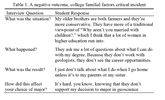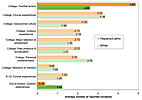Full Text View
Volume 24 Issue 1 (January 2014)
GSA Today
Article, pp. 52–53 | Abstract | PDF (122KB)
 |
| Table of Contents |
|---|
| Search GoogleScholar for Search GSA Today |
GROUNDWORK:
Why are there so few Hispanic students in geoscience?
1 Dept. of Geosciences, University of Arizona, Tucson, Arizona 85721, USA
2 Consultant, 168 Iris Street, Redwood City, California 94062, USA
3 Dept. of Geosciences, University of Arizona, Tucson, Arizona 85721, USA
Geoscience struggles to keep pace with the changing national demographics. Of all of the science, technology, engineering, and math (STEM) fields, geoscience has the least racial and ethnic diversity. In 2010, 20% of all U.S. bachelor’s degrees were awarded to underrepresented minorities, and fewer than 7% of bachelor’s degrees in geoscience were awarded to underrepresented minorities (NSF, 2013). Diversity benefits students’ academic development, awareness of cultures, professional societies, and the workforce (Chan, 2013; Velasco and Velasco, 2010). Explanations offered for the limited participation of minority students in geoscience include family influences, cultural differences, and hidden barriers (e.g., O’Connell and Holmes, 2011; Lewis and Baker 2010; Seymour and Hewitt, 1997). Few explanations have been tested, and progress toward greater participation of underrepresented minorities in geosciences has been slow.
Manuscript received 10 March 2013; accepted 8 Aug. 2013
doi: 10.1130/GSATG176GW.1
We used the Critical Incident Technique (CIT) (Flanagan, 1954) to examine the factors that affect student enrollment and persistence in geoscience. The CIT is a semi-structured interview technique that elicits reports of “critical incidents” in the subject’s past that influenced their actions, decisions, or attitudes. The CIT provides a way to collect and classify the otherwise anecdotal and qualitative nature of student narratives (Fig. 1). Incidents can then be quantitatively compared across categories, groups, and respondents. We followed Levine et al.’s (2007) classification for many of the factors influencing the choice of a geoscience major.
We identified critical incidents in the transcripts as events that affected the student’s feelings of self-confidence, desire to pursue a geoscience degree, persistence in the major, or perception of geoscience. If the student reported that the incident was worthwhile or supported their decision to major in geoscience, it was classified as a positive outcome. If the student reported that the incident was frustrating, created a hurdle to persistence, or detracted from their confidence about choice of major, it was classified as a negative outcome (Table 1).
|
A negative outcome, college familial factors critical incident |
We interviewed 29 current or former University of Arizona students: 17 females and 12 males. Eight students self-identified as Hispanic/Latino (Hispanic, hereafter) and 21 students self-identified as white, non-Hispanic/Latino (white, hereafter). We collected a grand total of 881 critical incidents. There was no significant difference in the average numbers of total critical incidents reported by Hispanic students and white students and no significant difference in the number of positive critical incidents between white and Hispanic students. However, Hispanic students reported more negative incidents than white students.
Whites and Hispanics differed significantly with respect to familial factors (Fig. 1). Per student, Hispanics reported twice as many critical incidents relating to familial factors during college than did whites. Furthermore, Hispanics reported five times more negative familial factors (2.5) than did whites (0.5).
|
Average number of critical incidents provided by white and Hispanic students, by category. Statistically significant (p < .05) findings shown in bold typeface and darker color. |
The only other significant difference we found between white and Hispanic geoscience majors is that fewer Hispanics reported out-of-school outdoor experiences—a factor associated with geoscience career choice.
Extended families are important to Hispanics. While white students typically reported familial factors involving just parents and siblings, Hispanic students often noted interactions with aunts, uncles, cousins, and grandparents as part of their decision-making processes. In addition, Hispanic geoscience majors had significantly more negative familial experiences than their white peers. This indicates that not only do Hispanic students have more family to satisfy, but Hispanics encounter more skepticism regarding their major choice from family members than do white geoscience students.
Cultural and familial factors are very important to Hispanic students (e.g., Chapa and De La Rosa, 2006; Munro, 2009). That the eight Hispanic students involved in this study were able to persist in geoscience speaks to their abilities to handle family-based criticisms of their major choice. How many potential Hispanic geoscience majors have been steered into other fields by their families?
Geoscientists are not as visible in the workforce as other scientists or engineers, and because there are so few Hispanics among them, parents may not easily see the value of the profession. Because Hispanic students encounter more skepticism when explaining their choice of a major to their family, it would serve geosciences well to provide prospective geoscience majors with information useful in their family discussions. Sharing information on employment opportunities, job security, and starting salaries in geoscience fields should help to convince families that geoscience is a worthwhile degree (e.g., Hoisch and Bowie, 2010). Similarly, efforts to encourage Hispanic students to persist to graduate school could also benefit from admission policies that acknowledge the importance of familial factors in students’ decisions. For example, the proximity of a student’s family to a graduate program may influence the decision to pursue an advanced degree.
Hispanic geosciences majors had fewer informal outdoor experiences before college than white geoscience majors. This adds to the challenge of recruiting Hispanic geoscience majors. For white students who grew up with many outdoor experiences, geoscience is, perhaps, an obvious fit. For Hispanic students who had fewer outdoor experiences, geoscience might require more personal adjustment. More informal outdoor experiences for Hispanic youth could result in more Hispanic undergraduate geoscience majors.
Familial factors are important to Hispanic students considering an undergraduate major in geosciences, and Hispanic students encounter more resistance from their families than do white students. While our sample size is small (n = 29; 881 critical incidents), it is larger than any previous study of differences between ethnic groups of geoscience majors. Our geographic scope is also small, being limited to one institution. Furthermore, our statistical approach to hypothesis testing only allows us to identify experiences that differ in prevalence for Hispanic and white students. Results should not be interpreted as indicating that factors such as “K–12 course experiences” or “research & mentors,” and the organizations that promote such activities, are unimportant—only that we are unable to detect differences in their prevalence. In these cases, the experiences appear to be equally important to both Hispanic and white majors. This study is a beginning: We make the usual call for more data and a broader scope. More focused efforts to provide Hispanic families with career information and educational outdoor experiences for their children may increase the number of Hispanic geoscience majors.
ACKNOWLEDGMENTS
We thank National Science Foundation award 0914401, the University of Arizona Graduate and Professional Student Council, Graduate College, Department of Geosciences, and The Geological Society of America for their support. QSR International donated NVivo 10 for critical incident analyses. This work is approved by the UA Human Subjects Research Office, IRB# 10-0834-02. Special thanks to Miriam Fuhrman of Rock Solid Testing Services and the American Institutes for Research.
References Cited
- Chan, M., 2013, Why does diversity matter to GSA?: GSA Today, v. 23, no. 7, p. 11.
- Chapa, J., and De La Rosa, B., 2006, The problematic pipeline: Demographic trends and Latino participation in graduate science, technology, engineering, and mathematics programs: Journal of Hispanic Higher Education, v. 5, no. 3, p. 203–221.
- Flanagan, J.C., 1954, The Critical Incident Technique: Psychological Bulletin, v. 51, no. 4, p. 327–358.
- Hoisch, T.D., and Bowie, J.I., 2010, Assessing factors that influence the recruitment of majors from introductory geology classes at Northern Arizona University: Journal of Geoscience Education, v. 58, no. 3, p. 166–176.
- Levine, R.L., Gonzalez, R., Cole, S., Fuhrman., M., and Le Floch, K.C., 2007, The geoscience pipeline: A conceptual framework: Journal of Geoscience Education, v. 55, no. 6, p. 458–468.
- Lewis, E.B., and Baker, D.R., 2010, A call for a new geoscience education research agenda: Journal of Research in Science Teaching, v. 47, no. 2, p. 121–129.
- Munro, J.L., 2009, Understanding decisions Latino students make regarding persistence in the science and math pipeline [Ph.D. thesis]: Tucson, University of Arizona, 264 p.
- NSF, 2013, National Science Foundation Integrated Science and Engineering Resources Data System (WebCASPAR), Raw data from National Center for Education Statistics (NCES) including IPEDS completions surveys NCES: https://webcaspar.nsf.gov/ (last accessed Jan. 2013).
- O’Connell, S., and Holmes, A., 2011, Obstacles to the recruitment of minorities into the geosciences: A call to action: GSA Today, v. 21, no. 6, p. 52–54.
- Seymour, E., and Hewitt, N.M., 1997, Talking about leaving: Why undergraduates leave the sciences: Boulder, Colorado, Westview Press, 427 p.
- Velasco, A.A., and Velasco, E.J., 2010, Striving to diversify the geosciences workforce: Eos, v. 91, no. 33, p. 289–296.

 Table 1
Table 1 Figure 1
Figure 1